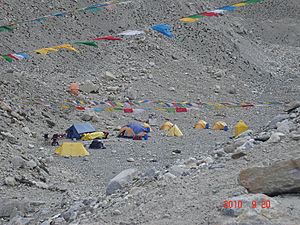Everest Base Camp facts for kids
An Everest Base Camp is a special campsite at the bottom of Mount Everest, the world's highest mountain. There are two main base camps, one on each side of the mountain. Mountain climbers use these camps as a starting point for their climb. They usually stay there for several days to get used to the high altitude. This helps them avoid getting sick from the thin air, which is called altitude sickness.
- The South Base Camp is in Nepal. It's about 5,364 metres (17,598 ft) high. Climbers use this camp when they want to climb Everest from the southeast side.
- The North Base Camp is in Tibet. It's a bit lower at 5,150 metres (16,900 ft) high. This camp is used for climbing Everest from the northeast side.
At the South Base Camp, food and gear are often carried by Sherpas (local people who help climbers) or porters, sometimes with the help of yaks. The North Base Camp has a road that vehicles can use, but usually only during the summer.
South Base Camp: The Nepal Side
The journey to the South Base Camp is one of the most popular hiking trips in the Himalayas. Thousands of people visit it every year!
Most trekkers fly from Kathmandu to a small town called Lukla. This saves a lot of time and energy before they start their hike. There are no roads from Kathmandu to Lukla, so planes are the only way to move heavy supplies. In 2015, about 40,000 people hiked from Lukla to the Nepal Everest Base Camp.
From Lukla, hikers walk uphill to Namche Bazaar, which is the main town for the Sherpa people. It's about 3,440 metres (11,290 ft) high. This part of the trek usually takes two days. When they reach Namche Bazaar, climbers often take a day to rest and get used to the altitude.
After that, they hike for another two days to Dingboche, which is 4,260 metres (13,980 ft) high. They rest there for another day to get even more used to the thin air. Finally, after two more days of hiking, they reach Everest Base Camp. They pass through a place called Gorakshep on the way.
In April 2015, a big earthquake hit Nepal. This earthquake caused a huge avalanche (a fast-moving slide of snow and ice) at the South Base Camp. Some of the trails leading to the camp were damaged and needed to be fixed.
North Base Camp: The Tibet Side
To visit the North Base Camp in China, you need special permission from the Chinese government. You also need a permit to visit Tibet itself. These permits must be arranged through travel companies in Lhasa. They will set up a tour that includes a vehicle, a driver, and a guide.
You can reach the North Base Camp by driving about 100 kilometers (62 miles) off the Friendship Highway. From the main Base Camp area, tourists must take special government buses. These buses limit traffic on the last part of the road to a marked hill. This hill is about 5,200 meters (17,060 feet) above sea level, just before the climbers' camp. If you're used to the altitude, you can also hike from the tourist camp.
The "tourist Base Camp" is about halfway between the Rongbuk Monastery and the actual climbers' Base Camp. The climbers' camp is right at the foot of the Rongbuk glacier.
Images for kids
See also
 In Spanish: Campo Base del Everest para niños
In Spanish: Campo Base del Everest para niños
















